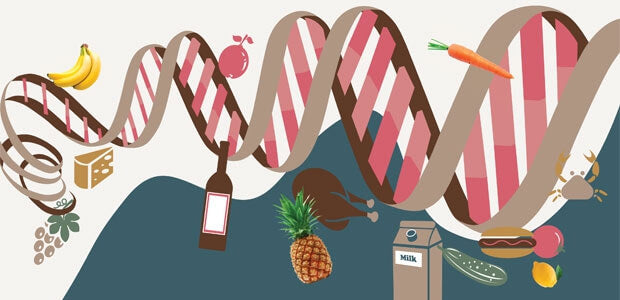
Beyond the DNA Code: The Power of Epigenetics
BioCertica Content TeamIf you were to examine the DNA of any two humans regardless of their ethnicity or background, you would find that their DNA sequence is 99.9% identical, so how are we, as humans, all so different? Well, that’s where we have to look beyond the DNA code and see how lifestyle factors such as diet and exercise can influence your fundamental makeup. Let's dive deeper into the field of epigenetics.
What is epigenetics?
Epigenetics translates to “above genetics.” It refers to the chemical modifications associated with DNA to express or silence genes. Epigenetics does not rely on the sequence of the bases that make up DNA but rather on the chemical markers that external factors can influence to change gene expression levels [1]. Epigenetics is also the driving force behind cell differentiation. If every cell in your body contains the same DNA, how does a liver cell know to express genes for liver enzymes and not pigment proteins? Moreover, how does a skin cell know to express genes for pigment proteins and not liver enzymes? That is where epigenetics comes in. Since your liver does not need pigment proteins, all genes that code for these proteins are silenced or "turned off," but all the genes for liver enzymes are expressed or "turned on." The reverse occurs in skin cells, where the liver enzyme genes are "turned off" and pigment-protein genes are "turned on." This kind of "turning on" and "turning off" genes occurs during embryo development [2]. This is the more "permanent" effect of epigenetics. Epigenetics also has an impact that constantly changes how much of a gene is expressed. This is the answer to the question, how are humans so different? You may express a particular gene at a specific rate, whereas your friend could express that same gene at twice your rate. Depending on what that gene does, the difference in expression could translate into a difference in any trait, such as physical performance capability, susceptibility to a disease, or even immune system response. These types of epigenetic modifications are also not necessarily "fixed" but can change throughout your life in response to your lifestyle [3]. Another way to consider this is to think of DNA as the hardware of who you are and epigenetics as the software. Your hardware does not change, but you constantly have software updates that affect how your hardware runs.
How does epigenetics work?
Epigenetics consists of two main chemical mechanisms, and they can be referred to as epigenetic markers. The first is methylation, which occurs when a methyl group (a carbon atom bonded to three hydrogen atoms) is bonded to the fifth carbon of the nucleic acid base cytosine by the enzyme DNA methyltransferases. The effect this causes is that the genes with these methyl groups are not expressed, which effectively “turns off” the gene, or one can say that the gene is silenced. This happens because the methyl group blocks the DNA from being read and made into protein. The lack of methylation markers will cause the gene to be “turned on.” Moreover, the second mechanism is called acetylation, and it involves adding an acetyl group (two carbon atoms, three hydrogen atoms, and an oxygen atom) to the DNA. Acetylation further emphasises the “turning on” effect of the gene as it enhances the accessibility of the gene to be used. Additionally, methylation and acetylation can also occur on histones, the proteins that DNA is wrapped around to enhance further the “turning on” or “turning off” effect [3].

Figure 1: Methylation on DNA and histones to silence gene expression.
Can epigenetics go wrong?
Just like with genetics, there can be mutations and mistakes in epigenetics. In the case of cancer, genes known as tumour suppressors can be hypermethylated, which means there is an excess amount of methyl groups on these groups. The result of this is that these genes are silenced and can no longer act to prevent cells from turning cancerous. Additionally, the genes that are reasonable for aiding cell survival can be over-acetylated and over-expressed, leading to the cells becoming cancerous [4].
Nature vs. nurture - blurring the lines
Lifestyle can effect and change your epigenetics. The most noticeable example of how epigenetics can affect an entire organism is to look at identical twins. From a DNA perspective, identical twins are clones of each other; their DNA sequences are an exact copy and paste, but are identical twins exact clones of each other? Well, one twin may be shorter than the other, develop a disease or condition that the other one did not, or see the effects of aging more prominently [5]. As far as health is concerned, it is possible to maintain a healthy epigenome through the correct nutrition. The diet components can contribute to how DNA methylation occurs and, thus, how gene expression occurs. B vitamins act as enzyme cofactors and help DNA methyltransferases to add methyl groups to cytosine. In addition, our bodies cannot synthesize the methyl groups and must obtain them from our diet. Without adequate nutrition, the epigenome is at risk of being modified, and this can lead to more issues along the line not only for the organism in question but also for the organism’s future offspring [6].
Why does epigenetics matter?
The biochemistry behind how an organism can function is extensive and can open doors for researchers to improve our understanding of life. These chemical reactions at a cellular level influence the functioning, behaviour, physical aspects, and mentality of an organism. External factors can alter the epigenome, which can then be passed down from generation to generation and ultimately affect the evolutionary chain. With this in mind, what future generations will be like concerning behaviour, mental state, and physical health is all directly linked to the current generation's decisions. A massive biological burden falls on today's society to ensure the stability of the future [3].
In conclusion, research into the epigenome is constantly expanding and providing scientists with more and more information as to how life functions at a biochemical level. Knowing how epigenetics works, what it entails, how it is regulated, what changes it and how it impacts evolution leads to improving understanding as to how major social problems can be changed or how to combat disease.
Written by: Jamie Fernandez, B.Sc Hons. in Genetics, Content Specialist
References
[1] U. Deichmann, “Epigenetics: The origins and evolution of a fashionable topic,” Dev. Biol., vol. 416, no. 1, pp. 249–254, Aug. 2016.
[2] P. Tulay, “Control of Embryonic Gene Expression and Epigenetics,” Embryo Cleavage, Sep. 2017.
[3] D. Latchman, Gene Control. New York: Garland Science, Taylor & Francis Group, 2010.
[4] S. Sharma, T. K. Kelly, and P. A. Jones, “Epigenetics in cancer,” Carcinogenesis, vol. 31, no. 1, p. 27, Sep. 2010.
[5] K. Cummings, S. Palladino, W. S. Klug, M. R. Cummings, C. A. Spencer, and M. A. Palladino, GLOBAL EDITION Concepts of Genetics ELEVENTH EDITION. 2016.
[6] J. Zhong et al., “B vitamins attenuate the epigenetic effects of ambient fine particles in a pilot human intervention trial,” Proc. Natl. Acad. Sci. U. S. A., vol. 114, no. 13, pp. 3503–3508, Mar. 2017.
[7] M. Pembrey, R. Saffery, and L. O. lo. Bygren, “Human transgenerational responses to early-life experience: potential impact on development, health and biomedical research,” Journal of medical genetics, vol. 51, no. 9. BMJ Publishing Group, pp. 563–572, 01-Sep-2014.
[8] D. Vågerö, P. R. Pinger, V. Aronsson, and G. J. van den Berg, “Paternal grandfather’s access to food predicts all-cause and cancer mortality in grandsons,” Nat. Commun., vol. 9, no. 1, pp. 1–7, Dec. 2018.
[9] M. E. Pembrey et al., “Sex-specific, male-line transgenerational responses in humans,” Eur. J. Hum. Genet., vol. 14, no. 2, pp. 159–166, Feb. 2006.
[10] G. Raad et al., “Paternal multigenerational exposure to an obesogenic diet drives epigenetic predisposition to metabolic disorders,” Obes. Diabetes, no. 7, p. 2020.05.19.104075, May 2020.
[11] S. E. King and M. K. Skinner, “Epigenetic Transgenerational Inheritance of Obesity Susceptibility,” Trends in Endocrinology and Metabolism, vol. 31, no. 7. Elsevier Inc., pp. 478–494, 01-Jul-2020.
[12] A. A. Lussier et al., “DNA methylation as a predictor of fetal alcohol spectrum disorder,” Clin. Epigenetics, vol. 10, no. 1, pp. 1–14, Jan. 2018.
[13] M. L. Masemola, L. van der Merwe, Z. Lombard, D. Viljoen, and M. Ramsay, “Reduced DNA methylation at the PEG3 DMR and KvDMR1 loci in children exposed to alcohol in utero: A South African Fetal alcohol syndrome cohort study,” Front. Genet., vol. 6, no. MAR, p. 85, Mar. 2015.



